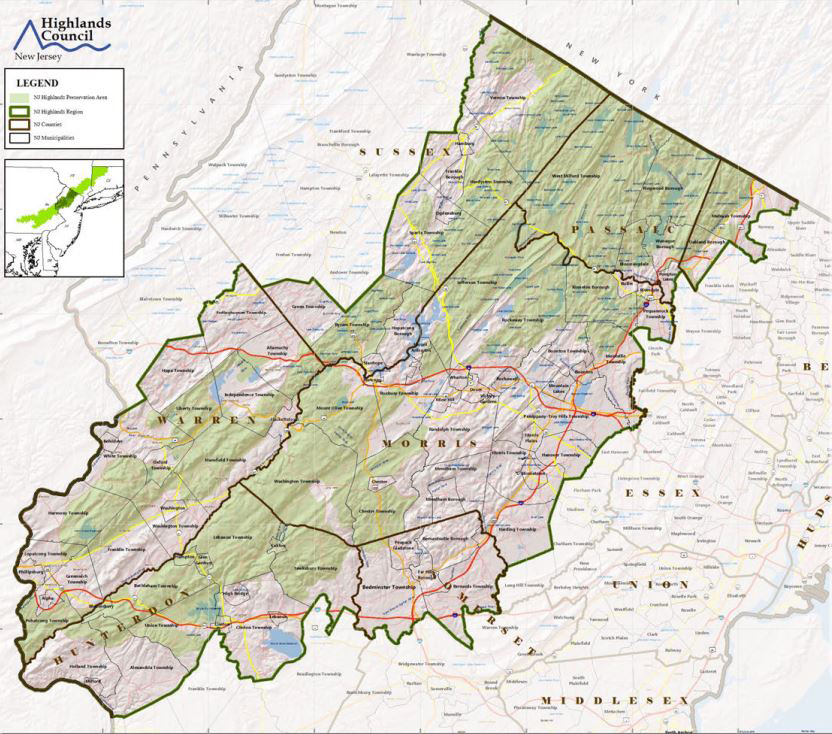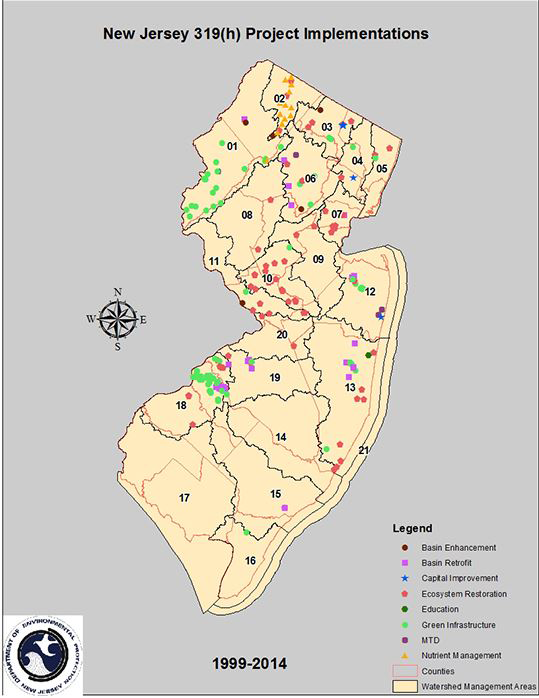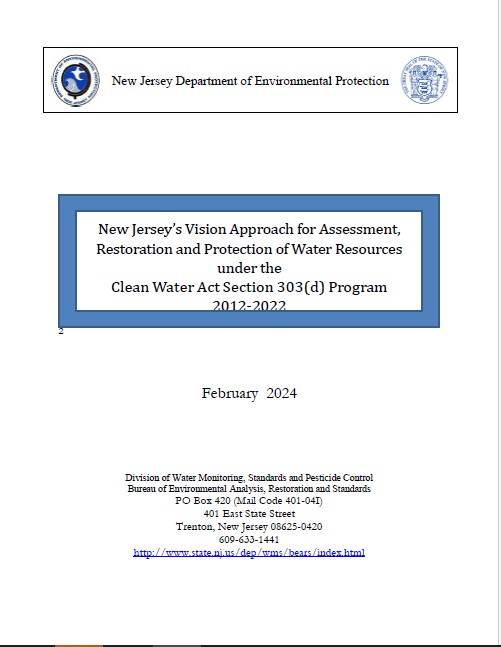
NJ Integrated Water Quality Assessment Report 2022 – Protection and Restoration Programs
Clean Water Act 303(d) List & 305(b) Report
The DEP over the last 50 years has been entrusted to protect and restore our precious resources by preventing pollution, cleaning up contamination, ensuring ample water supply and investing in strong infrastructure. Numerous programs within the DEP designed to protect, maintain, enhance, and restore water quality implement many regulatory and non-regulatory actions. These actions include developing TMDLs, issuing permits to upgraded wastewater dischargers, regulating stormwater, implementing land use management programs, providing restoration grants, managing nonpoint agricultural runoff, granting financial assistance for infrastructure construction, acquiring land, educating the community, protecting wetlands, controlling air quality, and enforcing compliance of water regulations.
Learn more about water the DEP’s pollution control programs under the “Water Pollution Control Programs” tab.
Learn more about a few highlighted programs below:
Total Maximum Daily Loads (TMDLs)
TMDLs are an important tool to begin to restore our impaired waterbodies. TMDLs diagnose the source of problems and quantify the necessary water quality recovery to assist the DEP in achieving its priorities of waters that are swimmable, fishable and safe for drinking. TMDLs take into consideration point and nonpoint sources of pollution, natural background water quality, surface water withdrawals, and other environmental factors through calculations or computer models to ensure the SWQS are met.
A TMDL implementation plan identifies the measures needed to reduce the pollutant loads from each pollutant source. Regulatory measures can be assigned to facilities and municipalities in the TMDL, including effluent limitations in permitted discharges. Non-regulatory measures include best management practices for agricultural land use and riparian restoration, as well as promotion of watershed/local stewardship activities such as construction of rain gardens and rain barrels.
Category 1 Waters
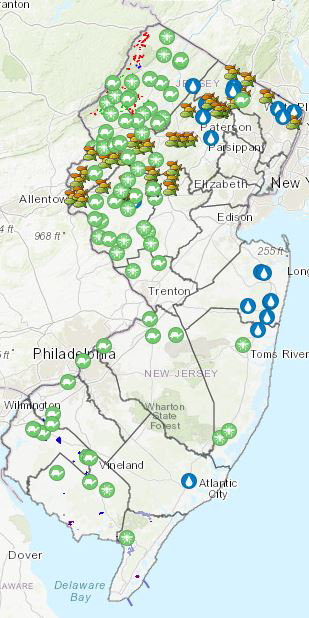
The SWQS establishes antidegradation policies for all surface waters of the State. The antidegradation policies require that all existing and designated uses shall be maintained and protected for all surface waters of the State; impaired waters must be restored to meet SWQS; and existing water quality shall be maintained.
One of the protective waterbody classifications is Category One (C1) waters. Category One waters are high quality streams, lakes and rivers designated through rulemaking for protection from measurable changes in water quality because of their exceptional ecological significance, exceptional water supply significance, exceptional recreational significance, and exceptional fisheries significance to protect and maintain their water quality, aesthetic value, and ecological integrity.
Recently, the DEP adopted amendments to the SWQS, that upgraded the antidegradation designation of approximately 600 river miles to Category One (C1) on March 4, 2020. The continual process of identifying high quality waters to receive C1 designation ensures that these resources are available for future generations. To date, approximately 7,400 river miles have been classified as C1; around 38 % of NJ waters. An additional 15% are Outstanding National Resource Waters (FW1 and PL) which also have strong protections.
Nonpoint Source Pollution Management Program
Addressing nonpoint sources (NPS) is a critical piece in the restoration efforts in the State. The NPS Management Program combines regulatory controls, non-regulatory strategies, watershed-based plans, restoration actions, and targeted funding to address NPS pollution. Every five years the program’s objectives and initiatives are updated in its Program Plan.
Many of the waters placed on the 303(d) List are impaired primarily by nonpoint sources of pollution and regulated stormwater sources. For these impairments, development of a watershed restoration plan or watershed based plan (WBP) can be an effective alternative to a formal TMDL to characterize pollutant sources, the reductions needed to attain standards, and the means to achieve the reductions. The 303(d) List depicts these impairments as 5R. The DEP has approved seventeen 9-element WBPs located throughout the state in addition to protection plans for the Raritan River Watershed and the Metedeconk River Watershed. These watersheds receive priority for NPS funding from the Water Quality Restoration Grant Program.
Water quality restoration grants are awarded by the DEP to fund watershed restoration activities and initiatives around New Jersey that address nonpoint source pollution. Generally, grants are focused on restoration of water quality impaired predominantly by NPS pollution for waters located in a priority waterbody or region where the grant will help implement an approved TMDL or Watershed Based Plan (WBP). Information about current and previous funding priorities, grant awards, and successful grant projects is provided in the link below.
DEP has funded the development of seventeen watershed restoration plans that meet USEPA’s recommended nine elements of a watershed based plan. The WBP work includes:

-
-
Map Key
-
 Alexauken Creek Watershed Plan
Alexauken Creek Watershed Plan Assiscunk Creek Watershed Plan
Assiscunk Creek Watershed Plan Cedar Grove Watershed Plan
Cedar Grove Watershed Plan Clove Brook Watershed Restoration Plan
Clove Brook Watershed Restoration Plan Long Swamp Creek Watershed Restoration Plan
Long Swamp Creek Watershed Restoration Plan Manalapan Watershed Restoration Plan
Manalapan Watershed Restoration Plan Metedeconk Watershed Plan
Metedeconk Watershed Plan Mulhockaway Creek Watershed Restoration Plan
Mulhockaway Creek Watershed Restoration Plan Neshanic River Watershed Restoration Plan
Neshanic River Watershed Restoration Plan Papakating Creek Watershed Restoration Plan
Papakating Creek Watershed Restoration Plan Pleasant Run & Holland Brook Watershed Restoration Plan
Pleasant Run & Holland Brook Watershed Restoration Plan Sidney Brook Protection Plan
Sidney Brook Protection Plan Sourland Mountain Watershed Plan
Sourland Mountain Watershed Plan Tenakill Brook Watershed Restoration
Tenakill Brook Watershed Restoration Upper Cohansey River Watershed Plan
Upper Cohansey River Watershed Plan Upper Salem River Watershed Plan
Upper Salem River Watershed Plan Wreck Pond Plan
Wreck Pond Plan
NJ Vision Approach for Assessment, Restoration and Protection
In 2013, USEPA issued guidance on a new vision and national goals for meeting the goals of the CWA Section 303(d). The Vision Document provides alternative strategies to restore impaired waters under USEPA’s emphasis on TMDLs as the sole means to attain designated uses and water quality standards. USEPA’s vision provides additional flexibility under the 303(d) Program for states to identify and prioritize waterbodies for restoration and protection through whatever means are appropriate under existing programs regulatory frameworks, and achieve water quality objectives in accordance with the state’s priorities.
Beginning with the 2014 Integrated Report, the DEP published the “New Jersey’s Vision Approach for Assessment, Restoration and Protection of Water Resources under the Clean Water Act Section 303(d) Program” explaining New Jersey’s strategy for managing the CWA Section 303(d) Program in accordance with guidance issued by USEPA. The new vision includes 6 goals: Engagement, Integration, Protection, Prioritization, Alternatives, and Assessment.
New Jersey’s Vision Approach is designed to accomplish both federal and State water quality goals through statewide ambient water quality monitoring, water quality standards that protect and support designated uses of New Jersey’s waters; assessment of water quality to determine support of designated uses; development, implementation and funding of strategies to protect and restore water resources; and communication and partnership with the public.
Delisting From 303(d) and Sublist 4
The DEP documents improvements in water quality through the delisting of impaired waters from the 303(d) List and Sublist 4. Delisting may be based on new data, approved TMDLs, or corrections to previous listings. Water quality improvements are only valid where new data confirms full support. Click on the link to see all delisting from 2020 to 2022 based on new water quality data.
NPS Success Stories
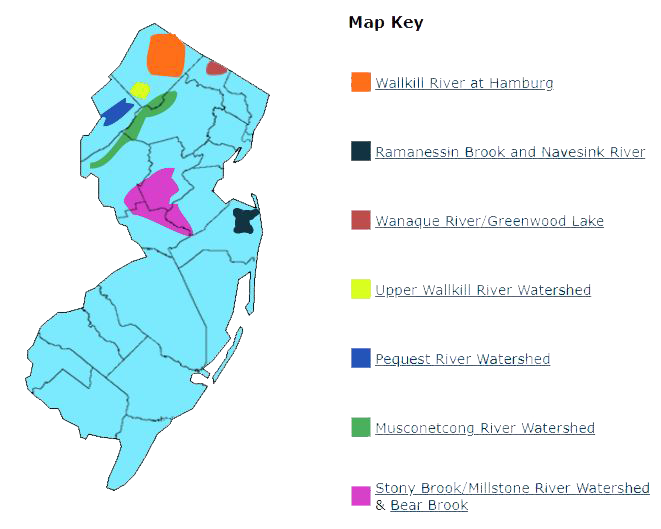
Efforts through the NPS Pollution Management Program has achieved measurable improvements in water quality. NPS success stories highlight waterbodies identified as being primarily nonpoint source-impaired and having achieved documented water quality progress.
This isn’t an all-inclusive list but spotlights several watersheds where strong partnerships in restoration efforts have resulted in improvements where previously impaired waters are now fully supporting
Water Quality Trends

Determining long-term trends is an excellent measure to evaluate changes in water quality and determine the effectiveness of water management programs. Long-term trends in New Jersey are showing improving conditions for nutrients and metals, degrading conditions for TDS and chlorides, while biological conditions are mostly stable.
Learn more by going to the Integrated Report’s section “Statewide Trends” under the “Statewide Water Quality” tab.
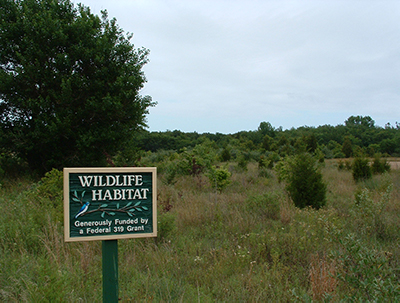
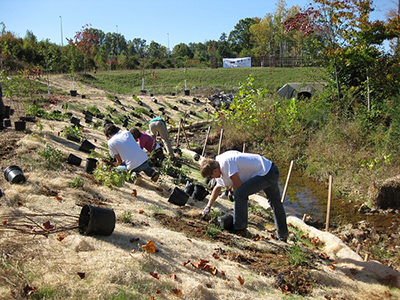
In the effort to optimize resources for restoration efforts, the DEP has initiated actions that identify and prioritize future nonpoint restoration efforts at a regional level. The goal of this effort is to maximize the utilization of restoration funding by identifying AUs that show the best potential for improving water quality and prioritizing these efforts.
The identification and prioritization of NPS restoration AUs involves a comprehensive assessment process and the results from the Recovery Potential Screening (RPS) tool.
The Department’s utilization of the RPS tool is the first step in the prioritization process, as it provides a ranking system on which further steps in the process are based. The RPS tool works on a series of weighted inputs/indicators. Local impacts and possible pollutant sources that are factored into the RPS tool include: point and nonpoint sources (such as NJPDES discharge, contaminated sites, landfills, and golf courses), land use loading associated with agriculture, urban, and impervious surfaces, riparian zone measurements, and stream habitat conditions. Restoration and protection accomplishments are also inputs to the RPS tool. These inputs include: C1 designated waters, TMDLs, completed restoration projects, and preserved open space areas. In the 2022 version of the RPS tool, new indicators were added and include climate change and Overburdened Communities (OBCs) in targeting restoration efforts.
The RPS tool’s analysis requires input layers to be split into three categories (e.g., ecological, stressor, and social indicators). Each input layer is weighted based on their relative effects on general water quality within New Jersey. In this cycle, thirty-three indicators were assigned a standardized weighting from one to three. Seven RPS indicators were assigned the highest weighting factor (a weight of three), which included both OBCs and climate change indicators. Because the 2022 Integrated Report focuses on the Northeast Water Region and this area of the state contains a relatively higher OBC presence, this RPS tool enhancement is particularly important. The Department is committed to the goal that “All New Jersey residents, regardless of income, race, ethnicity, color, or national origin, have a right to live, work, and recreate in a clean and healthy environment. Historically, New Jersey’s low-income communities and communities of color face a disproportionately high number of environmental and public health stressors and, as a result, suffer from increased adverse health effects. New Jersey seeks to correct these outcomes by furthering the promise of environmental justice.” More information on the Department’s Environmental Initiatives are available at the Environmental Justice webpage . Through this enhanced RPS tool, the public will be better served and protected.
In utilizing the customized RPS tool, each watershed subsequently receives an RPS score for assessment unit (AU) comparison. Based on RPS tool results, water quality and biological data are then reviewed for identification of assessment units that are near impairment status (i.e. “on the bubble”). If watersheds are identified as close to fully supporting criteria, these AUs are checked for improving water quality trends, for the magnitude and frequency of exceedances of the SWQS, for recent delistings from the 303(d) List, and for other pollutants that are fully supporting in the watershed. If verified, these areas can be assigned as restoration priority AUs.
The use of NJ’s custom version of EPA’s RPS tool offers a flexible, user-friendly, technically-based, and rapid identification of priority watersheds for restoration and protection. The RPS tool is an Microsoft Excel-based tool that provides a relative ranking of watersheds based on their condition and how well the areas may respond to management efforts.
Northeast Region Restoration Priorities
In the Northeast Water Region, 21 HUC14 watersheds were selected. A solid mix of rural and urban HUCs were selected through the inclusion of additional considerations that were not included in the RPS tool. In general, these waters were characterized by water quality data near or trending toward the criteria, healthy biological communities nearby, watersheds with a limited number of identified sources and causes, sufficient undeveloped land use, and intact or limited development in the riparian zones. It is expected that restoration efforts with achievable scopes and funding can make the changes needed in these watersheds to restore water quality not only in the headwaters and tributaries but as a collective effort downstream for the larger rivers. In addition, some more highly developed HUC14s were chosen based on municipalities that are focusing on Green Infrastructure projects.
Northeast Restoration Priority Assessment Units
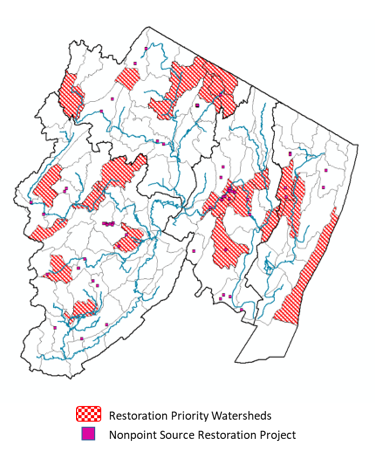
Northeast Total Maximum Daily Loads (TMDLs)
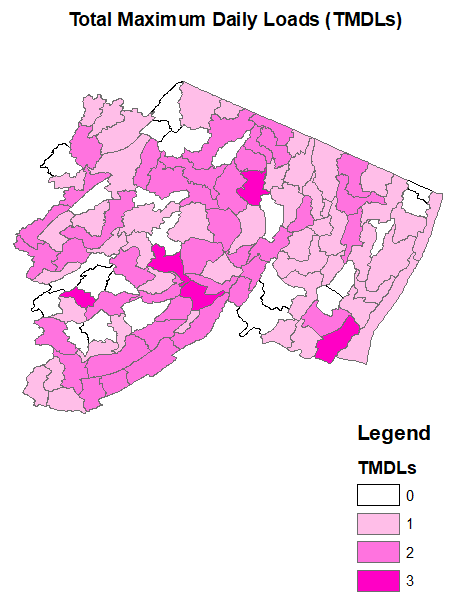
Impaired AUs with TMDLs.
(Darker colors indicate number of TMDLs in the AU)
TMDLs are an important tool to begin to restore our impaired waterbodies by identifying measures needed to reduce the pollutant loads from pollutant sources.
To date, the Northeast Water Region includes 49 TMDL reports to address E. coli, mercury in fish tissue, nickel, total phosphorus, and temperature water quality impairments. The TMDLs reports cover 131 parameter-HUC combinations and a significant portion of the Northeast Water Region.
As a result of TMDL implementation, the many water pollutant control programs, directed restoration funding, and numerous partnerships are continuing to improve water quality to resolve these waterbody impairments.
| TMDLs Northeast | WMA 03 | WMA 04 | WMA 05 | WMA 06 |
|---|---|---|---|---|
| Nickel | 2 | |||
| Escherichia coli | 8 | 16 | 6 | 26 |
| Temperature | 5 | |||
| Mercury in Fish Tissue | 10 | 4 | 7 | 11 |
| Phosphorus (Total) | 7 | 6 | 5 | 18 |
Northeast Category 1 Waters
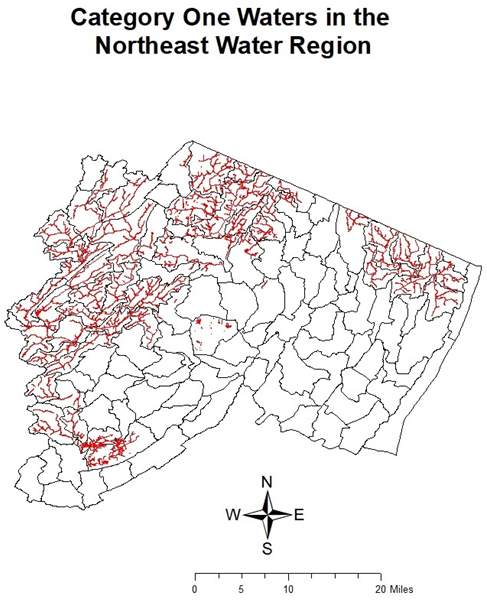
The DEP adopted amendments to the SWQS, that upgraded the antidegradation designation of approximately 670 river miles to Category One (C1) on March 4, 2020. Approximately 62 percent or ~413 river miles of the most recent protected stream are in the Upper and Lower Delaware Water Regions. To date, 7,436 river miles have been classified as C1; or ~38% of NJ waters. An additional 15% are Outstanding National Resource Waters (FW1 and PL) in NJ which also have strong protections.
Protections for the Northeast Water Region comprises 11% of the total C1 protected streams. 37% of the Northeast waters are C1 or FW1. The recent new protections include portions of the Ramapo River, Cresskill Brook, Bear Brook, Spring Brook, Fox Brook, and other waters.
Northeast Nonpoint Source Restoration Projects
The NJDEP’s Statewide Nonpoint Source Management Program is implemented cooperatively with many other water quality programs along with other State agencies, including the New Jersey
Department of Agriculture, local governments and the watershed associations. This program combines regulatory controls, non-regulatory strategies, watershed-based plans, restoration actions, and targeted funding to address NPS pollution on a scale that ranges from statewide to individual watersheds or sources of NPS.
There are 8 Watershed Based Plans (WBPs) in the Northeast Water Region. These plans outline projects and pollutant reductions in the Tenakill Brook, Whippany River, Hudson River, and Musquapsink Brook that are designed to restore water quality. These WBPs were completed through NJDEP and USEPA grants to regional planning partners. The DEP has prioritized implementation project funding in alignment with these WBPs.
Since 2000, the Department has completed at least 115 nonpoint source restoration projects in the region totaling over $4.75 million. These projects have included WBP development, streambank restoration, riparian buffer restoration, lake restoration, livestock control, stormwater controls including detention basin retrofits, agricultural and urban green infrastructure, impervious surface, and manufactured treatment devices. Recent efforts in the Northeast Water Region resulted in $1.3 million for new projects in 2019.
Recent DEP Funded Nonpoint Restoration Projects in the Northeast Region 2019
| Applicant / Project Name |
Funding Allocation |
Affected Waterbody |
Parameters Addressed |
Project Description |
|---|---|---|---|---|
| City of Newark Department of Water and Sewer Utilities, Ultrasonic Algae Control Treatment – Water Supply Reservoirs Serving the Pequannock Water Treatment Plant (WTP) | $475,000 | Echo Lake | HABs | The project proposes the use of ultrasonic technology deployed in clusters across the surface of the target reservoir, forming a “sound barrier” on the water’s surface to block cyanobacteria from photosynthesizing. This method is intended to reduce the intensity and duration of (or potentially eliminate) the cyanobacteria bloom, minimize potential impacts on human and animal health and aquatic resources, and control the harmful bloom itself within the water body. |
| North Hudson Sewerage Authority, Green Infrastructure Improvements in CSO Areas: Stormwater Retention Planter Boxes | $300,000 | Hudson River | TSS | NHSA will install three 900 square-foot stormwater planter boxes for trees and other cover plants in the towns of West New York and Weehawken. Together, these projects will reduce the volume of stormwater entering the combined sewer systems of Weehawken and West New York and serve as green infrastructure demonstration projects through their placement at schools and areas of public access |
| Greenwood Lake Commission, Nutrient Reduction Measures in Belcher Creek to Reduce HABs in Greenwood Lake | $52,800 | Belcher Creek Greenwood Lake |
HABs TP |
This project will follow the progress made to date on decreasing factors that contribute to HABs in Greenwood Lake, including data collection to establish the proper location for an innovative ferric sulfate injection system on Belcher Creek and the installation of Floating Wetland Islands to further decrease TP loading. |
| New Jersey Institute of Technology, Mechanical removal of HABs in lakes using air micro nano bubbles from a specialized floating platform | $500,000 | Branch Brook Lake Deal Lake |
HABs | This project will deploy a customized multifunctional floating platform in Branch Brook Lake and Deal Lake, two of the lakes affected by HABs in the summer of 2019. This in-situ algal removal technology aims to clarify HAB-affected waterbodies, including the surface and water columns as deep as 4-6 ft. Additional objectives include a long-term HAB strategy for Branch Brook Park Lake and evaluation of additional water quality improvements achieved by the platforms for parameters such as dissolved oxygen and turbidly. |
Examples of Completed Projects
 JFK High School grass area Before |
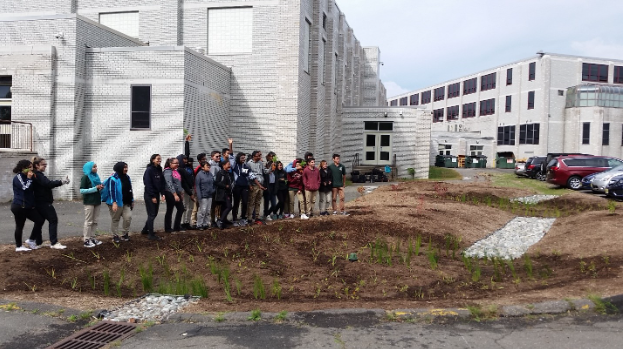 Newly planted rain garden AFTER |
 Patterson black top playground area BEFORE |
 Matured rain garden AFTER |
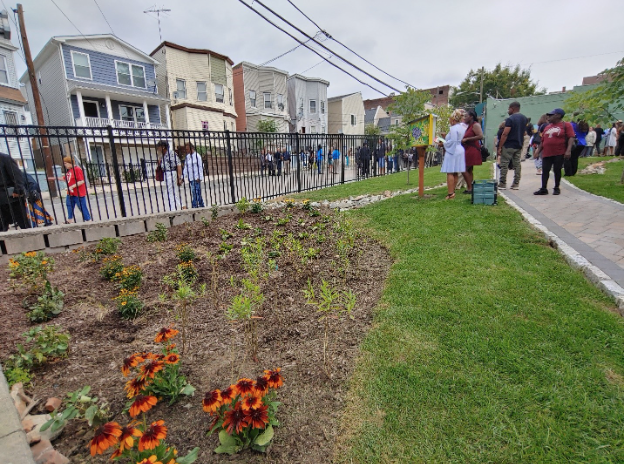 Newly planted rain garden at MLK Park |
|
Highlands Water Protection and Planning Act (Highlands Act)
The Highlands Act is a law signed in August 2004 that preserves open space and protects the State’s greatest diversity of natural resources including the precious water resources that supply drinking water to more than half of New Jersey’s families. The Highlands Act documents the geographical boundary of the Highlands Region and establishes the Highlands Preservation Area and the Highlands Planning Area.
The Highlands Act advocates for a regional approach to land use planning, requiring stringent resource protection policies while acknowledging that development, redevelopment, and economic growth in certain appropriate areas of the Region were also in the best interests of the state. The New Jersey Highlands Water Protection and Planning Council (Highlands Council) is a regional planning entity established in the Highlands Act and charged with its implementation. The Highlands Council works in partnership with municipalities and counties in the Region to encourage a comprehensive regional planning approach to implementation of the Highlands Act. Implementation is guided by the Highlands Regional Master Plan (RMP), adopted by the Council in 2008.
Area covered by the Highlands Act in New Jersey
